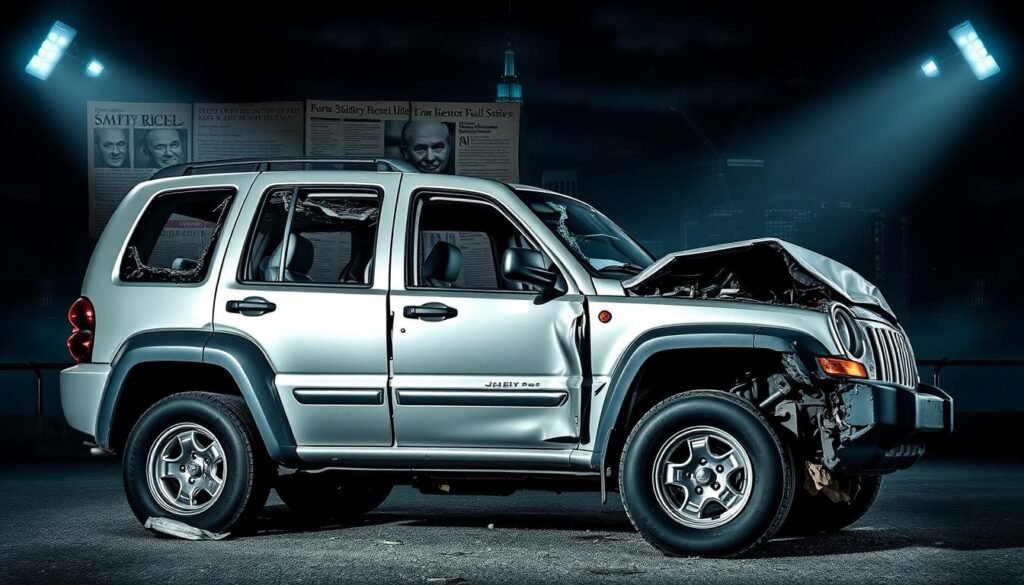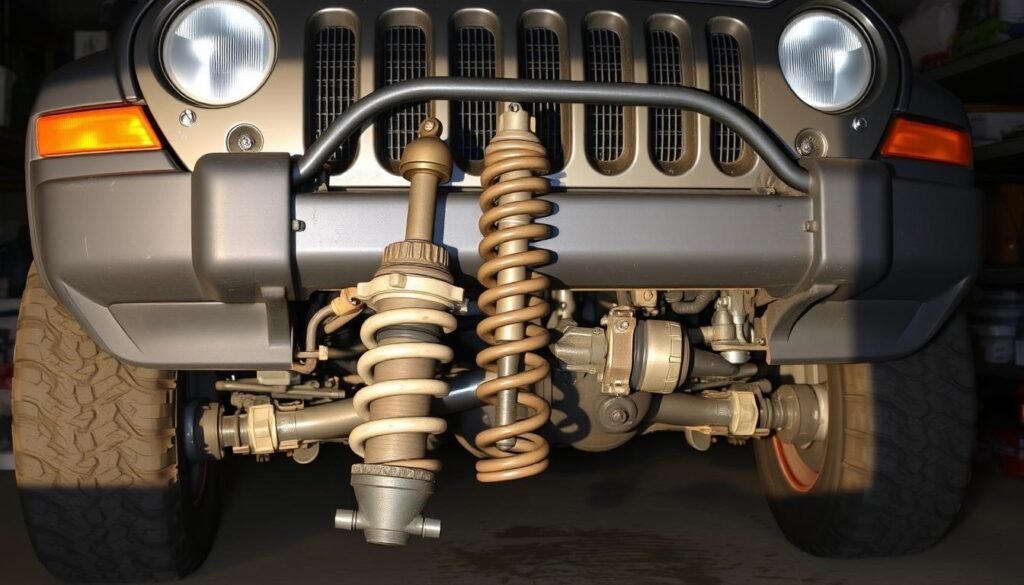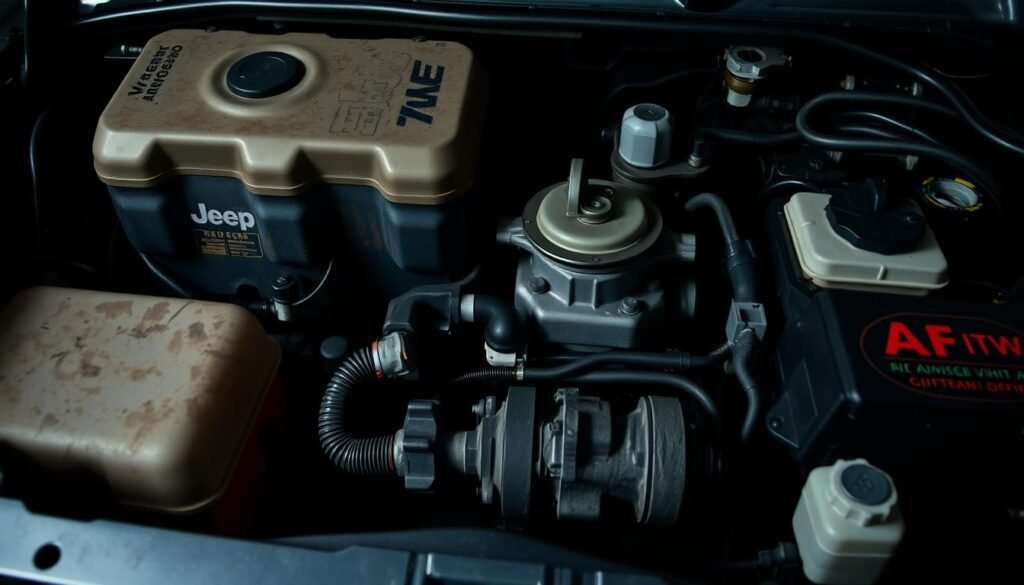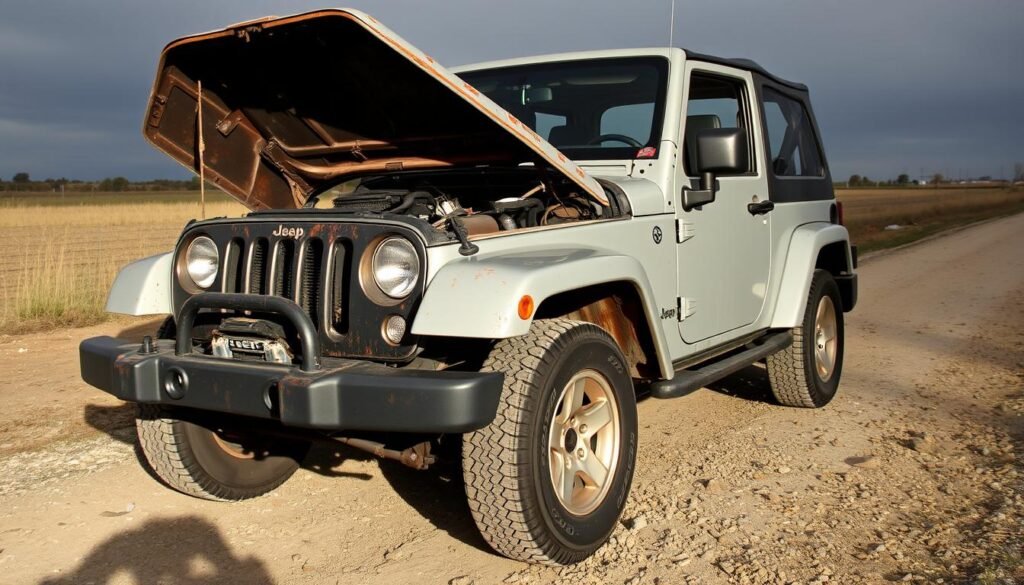The Jeep Liberty was made from 2002 to 2012. It was a compact SUV for those who love off-roading. Jeep Liberty problems grew as the model got older. Many mechanical and safety issues were found across different years.
In 2002, nearly 175,000 units were sold in the U.S. Despite its early success, it faced many mechanical problems. These issues made it hard to keep the vehicle reliable over time. Prices now range from $5,000 to $18,000, showing how much it has depreciated.
To understand the Jeep Liberty’s history, we must look at its mechanical weaknesses. This includes problems with the transmission and safety recalls. We will explore the main Jeep Liberty problems that buyers and owners need to know about.
Jeep Liberty Legacy and Production History
The Jeep Liberty was a key SUV in Chrysler’s lineup, fitting between compact and mid-size vehicles. Jeep Liberty problems were a big part of its story, but its impact goes beyond those issues.
Chrysler aimed to meet the changing SUV market with the Jeep Liberty. It was a new take on Jeep’s tough image, made for city and suburban drivers who wanted something versatile.
First Generation (2002-2007)
The first Jeep Liberty came out in 2002, taking the place of the Cherokee. It was known for:
- Strong off-road skills
- Compact SUV size
- Available in 2WD and 4WD
Second Generation (2008-2012)
In 2008, the Jeep Liberty got a big update, fixing some Jeep Liberty problems from before. The new model had:
- Better looks
- More comfortable inside
- Refined engine options
Market Impact and Discontinuation
Despite its bold design, the Jeep Liberty had trouble that led to its end in 2012. It got mixed reviews from buyers and had mechanical issues.
| Generation | Production Years | Key Characteristics |
|---|---|---|
| First Generation | 2002-2007 | Cherokee replacement, rugged design |
| Second Generation | 2008-2012 | Redesigned, improved features |
The Jeep Liberty’s story shows the tough times for car makers in the early 2000s. They faced big challenges in making cars that were both new and reliable.
Most Critical Mechanical Issues at 100,000 Miles
As Jeep Liberty vehicles hit 100,000 miles, owners start to see more mechanical problems. These issues can really affect how well the vehicle runs and how reliable it is. Knowing about these problems is key to keeping the SUV running smoothly for a long time.
The biggest mechanical worries include:
- Brake System Wear: You’ll need to replace brake pads and rotors a lot
- Window Regulator Failures: The electrical parts start to go wrong
- Drive shaft leakage and possible breakdown
Fixing these problems can cost a lot. Here are some repair price ranges:
- Head gasket issues: $2,000 to $5,000
- Cylinder head resurfacing: Up to $3,500
- Transmission repairs: Could be over $3,000
By 100,000 miles, the Jeep Liberty’s mechanical health often starts to slip. Its complex engine, with three timing chains, makes repairs harder and pricier. Regular maintenance is vital to prevent major engine failures.
It’s smart for both buyers and current owners to check high-mileage Jeep Libertys for signs of wear. Look out for unusual noises and performance issues. Catching these problems early can save a lot of time and money.
Jeep Liberty Problems: Common Failures and Warning Signs
Jeep Liberty owners face some challenges. Knowing these common issues helps catch problems early. This can save you from expensive repairs later.
The Jeep Liberty has had several mechanical issues. These problems can really affect how well the vehicle works and how reliable it is.
Window Regulator Failures
Window regulator failures are a big problem for Jeep Liberty owners. They often deal with:
- Windows getting stuck midway
- Difficulty raising or lowering windows
- Unusual grinding noises during window operation
Fixing power window problems can cost a lot. Preventive maintenance and catching issues early are important.
Transmission System Issues
Many Jeep Liberty models have transmission problems. Look out for these warning signs:
- Unexpected gear shifting
- Transmission fluid leaks
- Delayed engagement when shifting
“Regular transmission fluid checks can help prevent major costly repairs” – Automotive Expert
Cooling System Complications
The cooling system in Jeep Liberty vehicles can be a big challenge. About 209,000 vehicles were recalled for suspension and cooling system issues.
- Radiator leaks
- Overheating engine
- Coolant circulation problems
Fixing these problems early can save a lot of money. It also prevents damage to important vehicle systems.
Safety Concerns and Recall History

The Jeep Liberty had major safety issues that worried safety regulators. From 2002 to 2012, several critical problems came up. These issues put drivers and passengers at high risk.
The National Highway Traffic Safety Administration (NHTSA) looked into 2.7 million older Jeep SUVs. They were worried about fire risks from gas tanks in the back. Chrysler agreed to a big recall to fix these problems.
- Recall covered 1.56 million vehicles from 1992-2007
- Estimated recall cost: $151 million
- Fatal rear-impact fire crashes documented across multiple models
Jeep Liberty had serious safety flaws:
- At least five fatal rear-impact crashes
- Seven total fatalities linked to vehicle design
- NHTSA classified Liberty as a “poor performer” in safety ratings
The 2002 Jeep Liberty got very bad safety ratings. It scored low in crash tests and had fire risks from oil leaks. This made it the worst version of the vehicle.
Safety is not an option—it’s a fundamental requirement for any vehicle on the road.
Later models also had safety recalls. Problems included faulty reflectors, ball joints, and power windows. These ongoing issues hurt the vehicle’s reputation and made people lose trust.
Engine-Related Problems and Performance Issues
Jeep Liberty owners often face engine problems that affect how well the car runs. These issues can include sensor failures and oil leaks. They need quick attention and regular maintenance to fix.
Jeep Liberty owners should watch out for several engine problems. These can happen at any time during the car’s life:
- Frequent check engine light activations
- Unexpected power loss symptoms
- High oil consumption rates
- Sensor malfunction complications
Sensor Failures and Check Engine Lights
Jeep Liberty problems often show up as check engine light warnings. Powertrain Control Module (PCM) issues can cause these lights to come on. Replacing the module can cost between $200 and $500.
Diagnosing these problems can be tricky. It often requires a professional to find and fix the issue.
Oil Consumption Issues
The 2.4L PowerTech engine, used from 2002 to 2006, had oil consumption problems. It’s important for owners to check the oil regularly. They should also replace the timing belt at 120,000 miles to avoid engine damage.
Power Loss Symptoms
Jeep Liberty models can lose power for several reasons. These include:
- Compromised fuel delivery systems
- Ignition component failures
- Transmission performance degradation
Proactive maintenance and early diagnostic intervention are key to avoiding big engine problems in Jeep Liberty vehicles.
Suspension and Steering System Defects

Jeep Liberty owners face big problems with the suspension and steering. The biggest worry is ball joint failures. These can make driving unsafe.
A huge safety recall affects about 820,000 Jeep Liberty cars made from 2002 to 2006. The recall is for water getting into the front suspension ball joints. This can cause steering failures.
- Ball joint separation risks unexpected loss of steering control
- Vehicles built through March 15, 2006, are potentially impacted
- Dealers are mandated to stop sales and complete recall service
Jeep Liberty models show signs of suspension problems. You might feel the steering wheel vibrate, see uneven tire wear, or notice alignment issues. These signs mean you might have a serious suspension problem that needs a pro to check.
| Suspension Issue | Potential Consequences | Recommended Action |
|---|---|---|
| Ball Joint Failure | Loss of steering control | Immediate recall service |
| Water Intrusion | Corrosion and component degradation | Inspection and replacement |
| Lower Control Arm Wear | Reduced vehicle stability | Professional assessment |
It’s important for owners to check the suspension regularly. Fixing any issues early can stop steering failures in Jeep Liberty cars.
Electrical System Failures and Solutions
Jeep Liberty owners often face electrical system issues. These problems can affect how well the vehicle works and its safety. They can range from small annoyances to big mechanical failures that need a pro’s help.
Jeep Liberty electrical problems show up in different ways. Key areas include power windows, dashboard electronics, and wiring. Knowing these common issues can help owners fix problems before they get worse.
Power Window Malfunctions
Power window troubles are common in Jeep Liberty models. Here are some important facts:
- 20% of Jeep Liberty vehicles may experience window regulator failures
- Replacement costs range from $200 to $548 per window mechanism
- Often, multiple windows need to be replaced within the first 50,000 miles
Dashboard Electronic Issues
Dashboard electronics are another big concern. Intermittent electrical issues account for about 30% of all electrical system problems. Common issues include:
- Radio malfunctions
- Navigation system failures
- Instrument cluster inconsistencies
Wiring Problems
Wiring issues can really mess up a Jeep Liberty’s electrical system. Here are some important points:
- 15% of electrical problems come from wiring harness failures
- Fixing electrical issues can take 2-4 hours
- Fixing it can cost between $100-$200 per hour
Vehicle owners should make sure to check the electrical system regularly. They should also fix any warning signs quickly. This can prevent bigger problems and save on repair costs.
Fuel System and Economy Challenges

Jeep Liberty owners face fuel system issues that affect their vehicle’s performance and economy. The fuel efficiency of these vehicles is often lower than expected, averaging around 18 mpg.
Common fuel system problems for Jeep Liberty include:
- Oxygen sensor failures
- Fuel trim instability
- Diagnostic trouble codes affecting fuel economy
Jeep Liberty owners often see these diagnostic trouble codes:
| Code | Description | Typical Repair Cost |
|---|---|---|
| P0456 | Evaporative Emission System Leak | $200 – $560 |
| P0300 | Random/Multiple Cylinder Misfire | Less than $200 |
Proactive maintenance is key to managing Jeep Liberty fuel system problems. Owners should check oxygen sensors, use quality fuel additives, and fix warning lights quickly to avoid expensive repairs.
Regular diagnostic checks can save hundreds in fuel system repairs.
Fixing these fuel system issues can cost between $583 and $958 a year, depending on the model. Using preventive measures can reduce these costs and enhance vehicle performance.
Interior Components and Build Quality Issues
Many Jeep Liberty owners have faced problems with the interior. The build quality often doesn’t meet expectations. This leads to discomfort and dissatisfaction for drivers.
Several interior issues have been reported by owners. These problems affect the Jeep Liberty’s reliability:
- Seat frame durability concerns
- Dashboard material degradation
- Trim piece instability
- Electrical component failures
Statistics show the Jeep Liberty’s build quality issues:
| Component | Reported Issues | Severity |
|---|---|---|
| Seat Frames | Structural weakness | Medium |
| Dashboard | Material cracking | High |
| Electrical Systems | Intermittent failures | Medium |
Specific model years like 2002 and 2004 experienced more pronounced interior quality problems. Drivers often reported loose trim, rattles, and worn interior surfaces.
The Jeep Liberty’s reliability score is 56.35. This reflects the interior component challenges. Buyers should check used models for signs of wear. Look at the seats, dashboard, and electrical systems.
Cost Analysis of Common Repairs and Maintenance
Buying a Jeep Liberty means you’ll face certain costs. The average yearly repair cost is $674, which is more than the average for midsize SUVs at $573. These issues can greatly affect the cost of owning a Jeep Liberty over time.
The Jeep Liberty’s reliability rating is 3.5 out of 5.0. This means you might need to do more maintenance than other SUVs. You could face unscheduled repairs about 0.3 times a year, with a 12% chance of a major repair. Parts like the Powertrain Control Module (PCM) can cost between $100 and $500, depending on the type.
Regular maintenance can help avoid unexpected repair bills. You should keep an eye on the transmission, ball joints, and electrical parts. Also, check the window regulators, fuel systems, and suspension regularly. This can save you money on big repairs later on.
Planning your maintenance is key to handling Jeep Liberty issues. While it’s a versatile and unique vehicle, be ready for possibly higher repair costs than other SUVs in its class.
FAQ
What are the most common problems with the Jeep Liberty?
Jeep Liberty owners often face issues with window regulators and transmission failures. Brake system wear and suspension problems are also common. Electrical system malfunctions can happen too. Window regulators and transmission issues are more common in high-mileage models.
Are Jeep Liberty vehicles reliable at high mileage?
Jeep Liberty vehicles can be tough to keep running at high mileage. They may face drive shaft issues, brake wear, and engine sensor failures. These problems need regular maintenance and can be expensive to fix.
What years of the Jeep Liberty are considered most problematic?
The 2002-2007 models and early 2008-2009 models have more issues. The 2006 and 2007 models are known for suspension and mechanical problems.
How expensive are typical Jeep Liberty repairs?
Repair costs vary, but expect to spend 0 to ,500 for big repairs like transmission replacements. Window regulator fixes cost 0-0. Brake repairs can be 0 to 0.
What are the most serious safety concerns with the Jeep Liberty?
Safety issues include front suspension failures, rear suspension problems, and control arm defects. The 2006 and 2018 recalls addressed these critical issues. They could affect vehicle handling and safety.
Do Jeep Liberty vehicles have significant engine problems?
Yes, engine sensor issues, oil consumption, and power loss are common. Check engine lights often appear. Sensor failures can lead to expensive engine repairs.
How is the fuel economy of the Jeep Liberty?
The Jeep Liberty gets 16-22 miles per gallon, which is lower than many SUVs. Fuel system problems and old parts can reduce fuel efficiency in older models.
What should I check before buying a used Jeep Liberty?
Check the suspension, window regulators, transmission, electrical parts, and rust. A mechanic should inspect the vehicle before you buy. This can help find expensive problems.
Why was the Jeep Liberty discontinued?
Chrysler stopped making the Liberty in 2012. Sales were down, and the SUV market was competitive. They needed to update their SUV lineup. The Cherokee replaced the Liberty.
Are there any model years of the Jeep Liberty that are more reliable?
The 2010-2012 models are slightly more reliable. They have fewer major mechanical issues. But, maintenance and the vehicle’s history are key to reliability.


